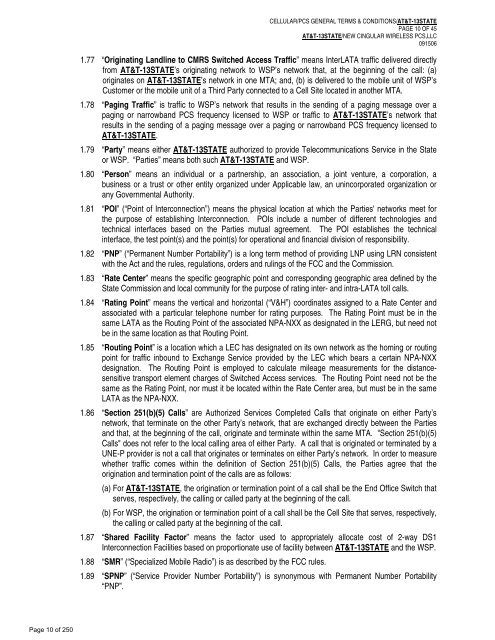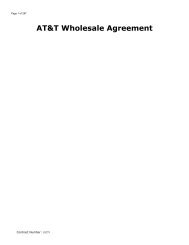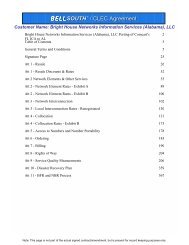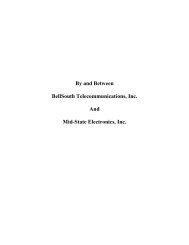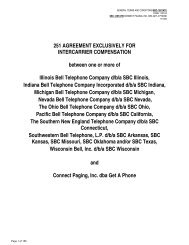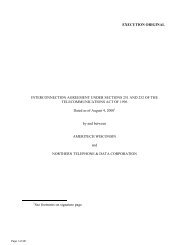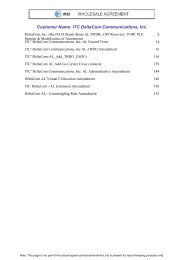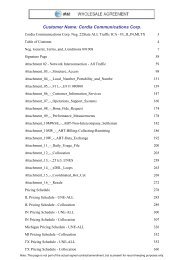CELLULAR/PCS INTERCONNECTION ... - AT&T Clec Online
CELLULAR/PCS INTERCONNECTION ... - AT&T Clec Online
CELLULAR/PCS INTERCONNECTION ... - AT&T Clec Online
You also want an ePaper? Increase the reach of your titles
YUMPU automatically turns print PDFs into web optimized ePapers that Google loves.
Page 10 of 250<br />
<strong>CELLULAR</strong>/<strong>PCS</strong> GENERAL TERMS & CONDITIONS/AT&T-13STATE<br />
PAGE 10 OF 45<br />
AT&T-13STATE/NEW CINGULAR WIRELESS <strong>PCS</strong>,LLC<br />
091506<br />
1.77 “Originating Landline to CMRS Switched Access Traffic” means InterLATA traffic delivered directly<br />
from AT&T-13STATE’s originating network to WSP’s network that, at the beginning of the call: (a)<br />
originates on AT&T-13STATE’s network in one MTA; and, (b) is delivered to the mobile unit of WSP’s<br />
Customer or the mobile unit of a Third Party connected to a Cell Site located in another MTA.<br />
1.78 “Paging Traffic” is traffic to WSP’s network that results in the sending of a paging message over a<br />
paging or narrowband <strong>PCS</strong> frequency licensed to WSP or traffic to AT&T-13STATE’s network that<br />
results in the sending of a paging message over a paging or narrowband <strong>PCS</strong> frequency licensed to<br />
AT&T-13STATE.<br />
1.79 “Party” means either AT&T-13STATE authorized to provide Telecommunications Service in the State<br />
or WSP. “Parties” means both such AT&T-13STATE and WSP.<br />
1.80 “Person” means an individual or a partnership, an association, a joint venture, a corporation, a<br />
business or a trust or other entity organized under Applicable law, an unincorporated organization or<br />
any Governmental Authority.<br />
1.81 “POI” (“Point of Interconnection”) means the physical location at which the Parties' networks meet for<br />
the purpose of establishing Interconnection. POIs include a number of different technologies and<br />
technical interfaces based on the Parties mutual agreement. The POI establishes the technical<br />
interface, the test point(s) and the point(s) for operational and financial division of responsibility.<br />
1.82 “PNP” (“Permanent Number Portability”) is a long term method of providing LNP using LRN consistent<br />
with the Act and the rules, regulations, orders and rulings of the FCC and the Commission.<br />
1.83 “Rate Center” means the specific geographic point and corresponding geographic area defined by the<br />
State Commission and local community for the purpose of rating inter- and intra-LATA toll calls.<br />
1.84 “Rating Point” means the vertical and horizontal (“V&H”) coordinates assigned to a Rate Center and<br />
associated with a particular telephone number for rating purposes. The Rating Point must be in the<br />
same LATA as the Routing Point of the associated NPA-NXX as designated in the LERG, but need not<br />
be in the same location as that Routing Point.<br />
1.85 “Routing Point” is a location which a LEC has designated on its own network as the homing or routing<br />
point for traffic inbound to Exchange Service provided by the LEC which bears a certain NPA-NXX<br />
designation. The Routing Point is employed to calculate mileage measurements for the distancesensitive<br />
transport element charges of Switched Access services. The Routing Point need not be the<br />
same as the Rating Point, nor must it be located within the Rate Center area, but must be in the same<br />
LATA as the NPA-NXX.<br />
1.86 “Section 251(b)(5) Calls” are Authorized Services Completed Calls that originate on either Party’s<br />
network, that terminate on the other Party’s network, that are exchanged directly between the Parties<br />
and that, at the beginning of the call, originate and terminate within the same MTA. "Section 251(b)(5)<br />
Calls" does not refer to the local calling area of either Party. A call that is originated or terminated by a<br />
UNE-P provider is not a call that originates or terminates on either Party’s network. In order to measure<br />
whether traffic comes within the definition of Section 251(b)(5) Calls, the Parties agree that the<br />
origination and termination point of the calls are as follows:<br />
(a) For AT&T-13STATE, the origination or termination point of a call shall be the End Office Switch that<br />
serves, respectively, the calling or called party at the beginning of the call.<br />
(b) For WSP, the origination or termination point of a call shall be the Cell Site that serves, respectively,<br />
the calling or called party at the beginning of the call.<br />
1.87 “Shared Facility Factor” means the factor used to appropriately allocate cost of 2-way DS1<br />
Interconnection Facilities based on proportionate use of facility between AT&T-13STATE and the WSP.<br />
1 .88 “SMR” (“Specialized Mobile Radio”) is as described by the FCC rules.<br />
1.89 “SPNP” (“Service Provider Number Portability”) is synonymous with Permanent Number Portability<br />
“PNP”.


